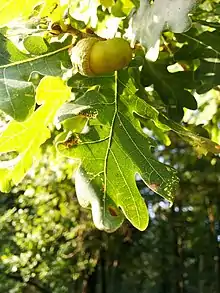Quercus × rosacea
Quercus × rosacea (or Quercus rosacea), is a naturally occurring hybrid species of oak native to Europe. They are the offspring of sessile oak, Quercus petraea, and common oak, Quercus robur, found where their ranges overlap. As hybrids, they are morphologically variable, but in general their traits appear intermediate to those of the parents. A thin section of a Q. × rosacea specimen was used by artist-in-residence Tania Kovats to create a monumental work called TREE for the ceiling of the Mezzanine of the Natural History Museum, London in celebration of the bicentennial of Charles Darwin's birth.[2]
| Quercus × rosacea | |
|---|---|
 | |
| Leaf cluster with acorn | |
| Scientific classification | |
| Kingdom: | Plantae |
| Clade: | Tracheophytes |
| Clade: | Angiosperms |
| Clade: | Eudicots |
| Clade: | Rosids |
| Order: | Fagales |
| Family: | Fagaceae |
| Genus: | Quercus |
| Species: | Q. × rosacea |
| Binomial name | |
| Quercus × rosacea | |
| Synonyms | |
| |
References
- Sylvan, 67, 1813
- Hellström, Nils Petter (2011). "The tree as evolutionary icon: TREE in the Natural History Museum, London (William T. Stearn Prize 2010)". Archives of Natural History. 38 (1): 1–17. doi:10.3366/anh.2011.0001. PMID 21560437.
This article is issued from Wikipedia. The text is licensed under Creative Commons - Attribution - Sharealike. Additional terms may apply for the media files.